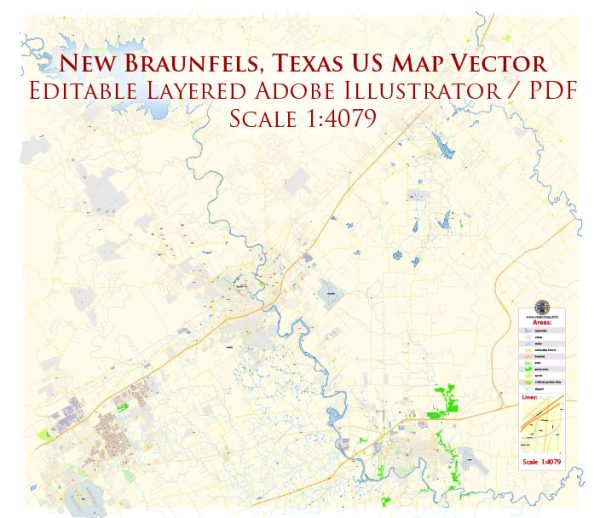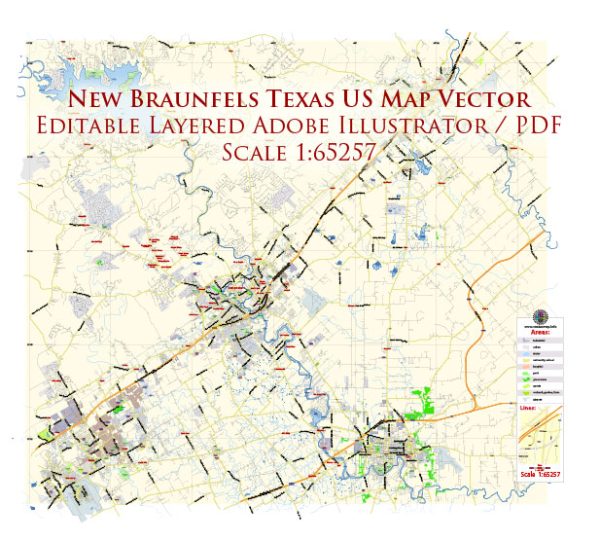New Braunfels, Texas, is a city with a rich history and a vibrant downtown area. Located in the Central Texas Hill Country, New Braunfels is known for its German heritage, historic architecture, and charming small-town atmosphere.
Vectormap.Net provide you with the most accurate and up-to-date vector maps in Adobe Illustrator, PDF and other formats, designed for editing and printing. Please read the vector map descriptions carefully.
Here’s a detailed description of its history and main streets:
History of New Braunfels
Early Settlement and German Immigration
- Founding (1845): New Braunfels was founded in 1845 by German immigrants led by Prince Carl of Solms-Braunfels. They established the town as part of the larger plan for German colonization in Texas. The town was named after Braunfels, a town in Germany.
- Early Development: The settlers built homes, businesses, and churches, and the town grew as a center for German culture and commerce. Agriculture, particularly cotton and livestock, became significant to the local economy.
- Economic Growth: Throughout the late 19th and early 20th centuries, New Braunfels continued to develop as a regional trade center. The construction of railroads helped boost its economy by improving transportation and trade.
20th Century to Present
- Tourism and Recreation: In the latter half of the 20th century, New Braunfels became known for its recreational opportunities. The city’s location along the Comal and Guadalupe Rivers made it a popular destination for tubing, fishing, and other water activities.
- Historic Preservation: Efforts to preserve the city’s historic buildings and heritage have been ongoing, contributing to New Braunfels’ charm and attracting visitors interested in its history and culture.
- Modern Era: Today, New Braunfels is known for its festivals, historic downtown area, and as a gateway to the Hill Country. It continues to grow as a residential and tourist destination while maintaining its historical character.
Main Streets of New Braunfels
Historic Downtown Area
- Overview: The historic downtown area of New Braunfels is known for its well-preserved 19th-century architecture, charming shops, restaurants, and cultural attractions.
Main Street
- Description: Main Street is the heart of New Braunfels’ historic downtown. It features a mix of historic buildings, boutique shops, cafes, and restaurants. The street often hosts community events, parades, and festivals.
- Notable Buildings: Historic buildings along Main Street include the old New Braunfels City Hall, the New Braunfels Historic District, and various examples of German-style architecture.
Marketplatz
- Description: Located at the intersection of Main Street and San Antonio Street, Marketplatz is a central public square and gathering place in downtown New Braunfels. It is used for local events, farmer’s markets, and festivals.
- Historical Significance: The square has been a focal point for community activities and celebrations since the town’s early days.
San Antonio Street
- Description: Running parallel to Main Street, San Antonio Street is another important thoroughfare in downtown New Braunfels. It is home to a variety of businesses, historic buildings, and residential areas.
- Key Attractions: The street is notable for its historical homes and its role in connecting various parts of the city.
Landa Street
- Description: Landa Street is known for its residential areas and its connection to Landa Park, a large public park featuring the Landa Park Golf Course and the Landa Park Springs.
- Key Attractions: The park is a major recreational area, offering walking trails, picnic areas, and a large spring-fed pool.
Gruene Historic District
- Description: Located just north of downtown, the Gruene Historic District is a historic area known for its preserved 19th-century buildings, including the famous Gruene Hall, the oldest continually operating dance hall in Texas.
- Key Attractions: Gruene Hall, antique shops, and the historic Gruene Mansion Inn.
Summary
New Braunfels, Texas, has a rich historical heritage that is reflected in its well-preserved architecture and vibrant downtown area. The city’s main streets, such as Main Street, Marketplatz, and San Antonio Street, are central to its historical and cultural character. The Gruene Historic District adds to the charm with its preserved buildings and historic sites. New Braunfels continues to celebrate its German roots while offering a welcoming atmosphere for residents and visitors alike.



 Author: Kirill Shrayber, Ph.D.
Author: Kirill Shrayber, Ph.D.